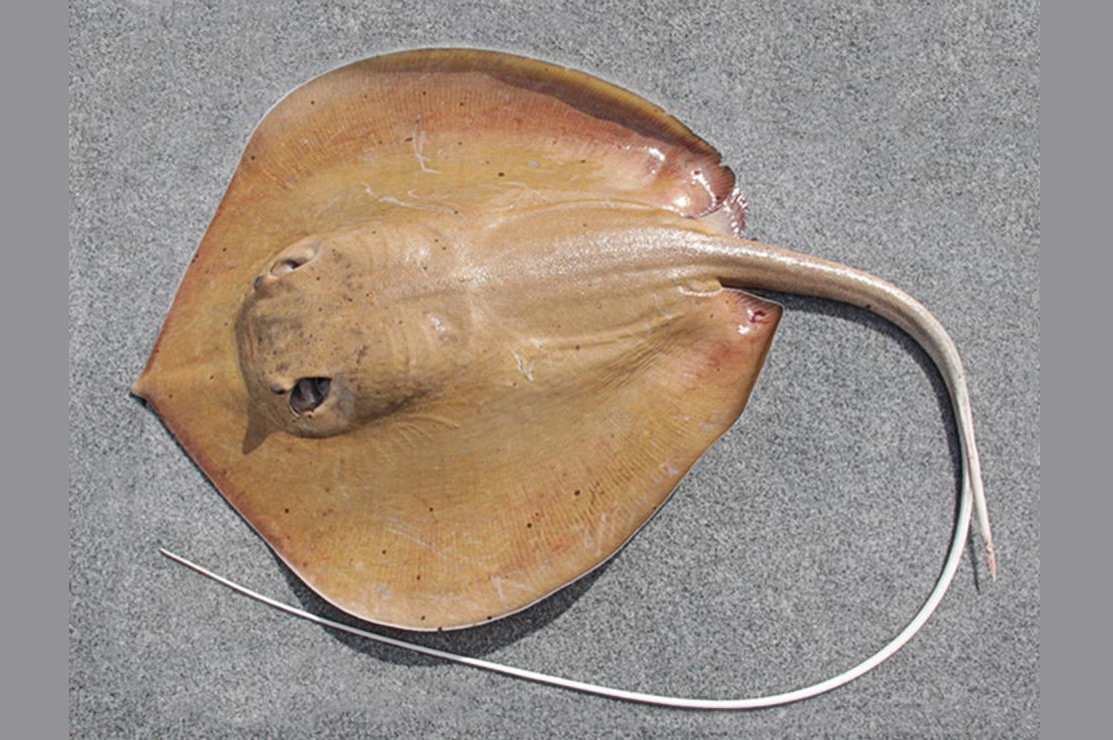- Classification
- CHONDRICHTHYES
- MYLIOBATIFORMES
- DASYATIDAE
- Urogymnus
- acanthobothrium
Mumburarr Whipray, Urogymnus acanthobothrium Last, White & Kyne 2016
Other Names: Mumburarr

Holotype of the Mumburarr Whipray, Urogymnus acanthobothrium, WAM P.34488-001, juvenile male from Cambridge Gulf, Western Australia. Source: Peter Kyne / Charles Darwin University. License: CC BY Attribution
Summary:
A yellowish-brown whipray, sometimes with a greenish tinge and often irregularly covered in fine greyish speckles, a pale to almost white tail, and a white underside. This large whipray inhabits brackish and marine environments.
The species has very small eyes positioned in front of the large spiracles, a well-developed denticle band, a long narrow-based whip-like tail, and no enlarged thorns on the body.
The species has very small eyes positioned in front of the large spiracles, a well-developed denticle band, a long narrow-based whip-like tail, and no enlarged thorns on the body.
Cite this page as:
Bray, D.J. 2021, Urogymnus acanthobothrium in Fishes of Australia, accessed 03 Jul 2025, https://fishesofaustralia.net.au/Home/species/5257
Mumburarr Whipray, Urogymnus acanthobothrium Last, White & Kyne 2016
More Info
|
Distribution |
Ord River and Cambridge Gulf, Western Australia, to the Alligator River, Northern Territory; Elsewhere the species occurs in the Gulf of Papua, Papua New Guinea. Inhabits sandy and muddy coastal areas, and estuaries and the brackish reaches of tidal rivers, at depths to 60 m. |
|
Features |
Distinguished by the following set of characters: disc elongate suboval, snout tip to axis of maximum width 53% DW; anterior disc margin not truncated, almost straight, lateral apices broadly rounded; preorbital snout broadly angular, angle 114°, with a very small apical lobe; preorbit long, length 26% TL, 2.1 times interorbital length; orbits small, protruded slightly; spiracle very large, 8.6% DW, 1.9 in orbit diameter; internasal distance 2.0 in prenasal length, 2.8 times nostril length; preoral snout length 2.6 times mouth width, 2.5 times internarial distance; caudal sting very large, length more than a 30% DW; mid-scapular denticles very small and inconspicuous; secondary denticles very small, rather widely spaced, band delimited but margin not sharply defined, band truncate forward of eye; minute upright tertiary denticles present, barely visible; low and short-based ventral tail fold present; propterygial radials 66, 3 times the number of mesopterygial radials; total vertebral segments (excluding synarcual) 151. |
|
Colour |
Dorsal disc colour variable, plain dark greyish brown to yellowish brown in juveniles, very finely and faintly mottled greyish white to yellowish brown in adults; ventral surface largely white, posterior disc without regular dark margins; tail beyond sting white in young, unknown but possibly paler than anterior tail in adults. |
|
Biology |
Reproductive mode: viviiparous with histiotrophy. Males mature at ~110 cm DW; largest known embryo ~28 cm DW. |
|
Similar Species |
Differs from the closely related Mangrove Whipray, Urogymnus granulatus, in having a low skin fold on the underside of the tail, a longer and more angular snout, and a longer tail. The Mumburarr Whipray also lacks white flecks on the upperside, and the underside is uniformly white (vs. white with a broad black margin in U. granlatus).The similar Hortle's Whipray, Pateobatis hortlei, differs in having a much thicker disc (vs. disc thin in U. acanthobothrium), a whitish tail (vs. tail darker than disc) and a shorter snout (vs. snout very long). |
|
Etymology |
A large female collected during a survey of cestode parasites of northern Australian chondrichthyan fishes yielded 4 species of cestodes (tapeworms) of the genus Acanthobothrium that are found only in this species (Fyler et al., 2009). Hence, the species is named acanthobothrium in recognition of the historical significance of the parasite project in the discovery of this whipray. The vernacular name ‘Mumburarr Whipray’ is used to acknowledge the assistance of Traditional Owners in locating this species, in particular the people of the Alligator Rivers region in the Northern Territory. Mumburarr is a local Limilngan language name used by the Minitja people of the West Alligator River region meaning stingray. Coastal, estuarine and riverine stingrays were traditionally hunted for food and the caudal sting was used as a traditional knife. |
|
Species Citation |
Urogymnus acanthobothrium Last, White & Kyne 2016, Zootaxa 4147(2): 163, figs 1-7. Type locality: West Arm of Cambridge Gulf, Western Australia, 15°33′S, 127°59′E, depth 2.2 m. |
|
Author |
Bray, D.J. 2021 |
|
Resources |
Mumburarr Whipray, Urogymnus acanthobothrium Last, White & Kyne 2016
References
Last, P.R., Manjaji-Matsumoto, B.M., Naylor, G.J.P. & White, W.T. 2016. Dasyatidae. pp. 522-618 in Last, P.R., White, W.T., Carvalho, M.R. de, Séret, B., Stehmann, M.F.W. & Naylor, G.J.P. (eds). Rays of the World. Clayton South, Victoria : CSIRO Publishing 790 pp.
Last, P.R., White, W.T. & Kyne, P.M. 2016. Urogymnus acanthobothrium sp. nov., a new euryhaline whipray (Myliobatiformes: Dasyatidae) from Australia and Papua New Guinea. Zootaxa 4147(2): 162-176 http://dx.doi.org/10.11646/zootaxa.4147.2.4
White, W.T., Baje, L., Sabub, B., Appleyard, S.A., Pogonoski, J.J. & Mana, R.R. 2017. Sharks and Rays of Papua New Guinea. Australian Centre for International Agricultural Research Monograph Series 189: 1-327 See ref online
White, W.T. & Ko'ou, A. 2018. An annotated checklist of the chondrichthyans of Papua New Guinea. Zootaxa 4411(1): 1-82. https://doi.org/10.11646/zootaxa.4411.1




